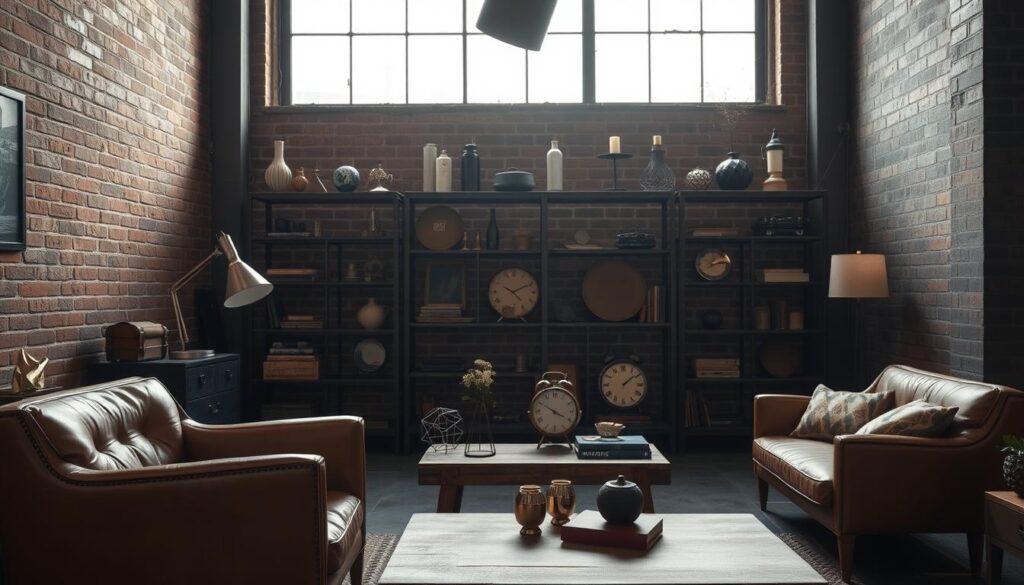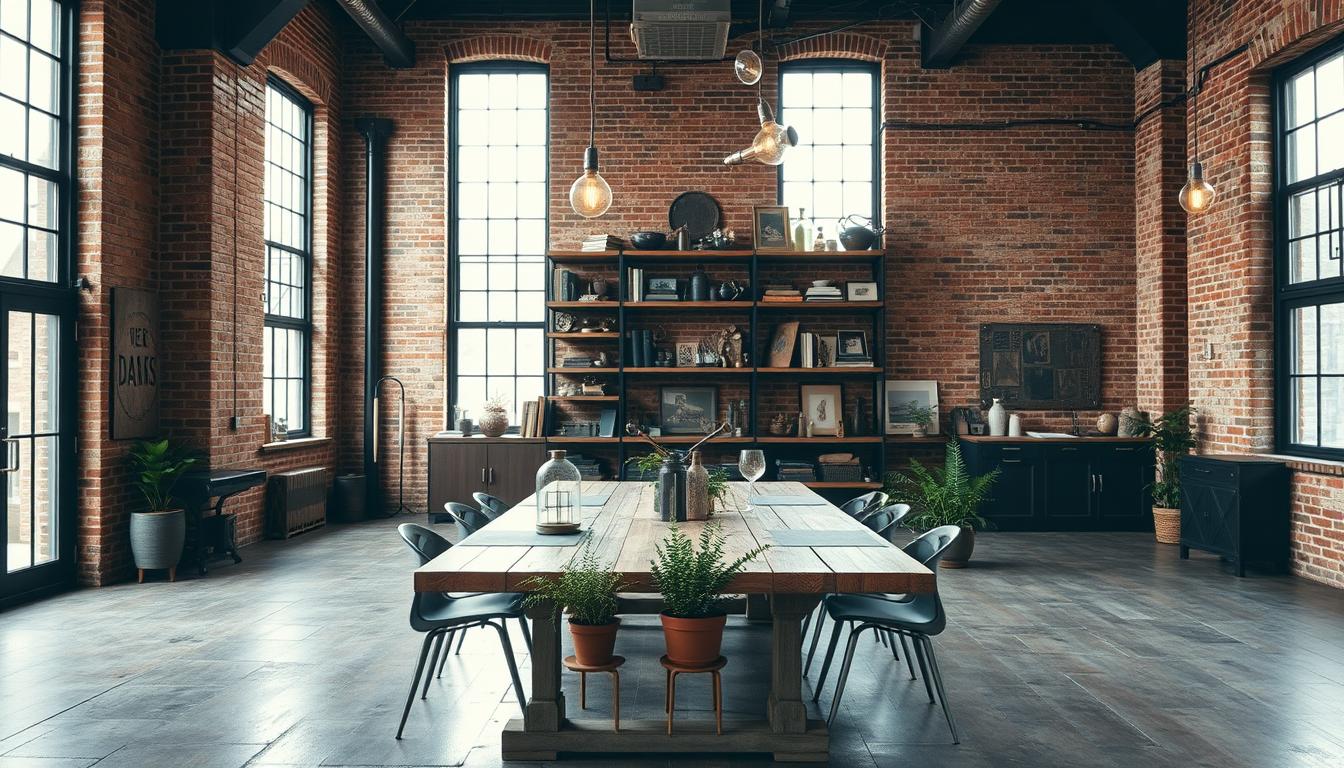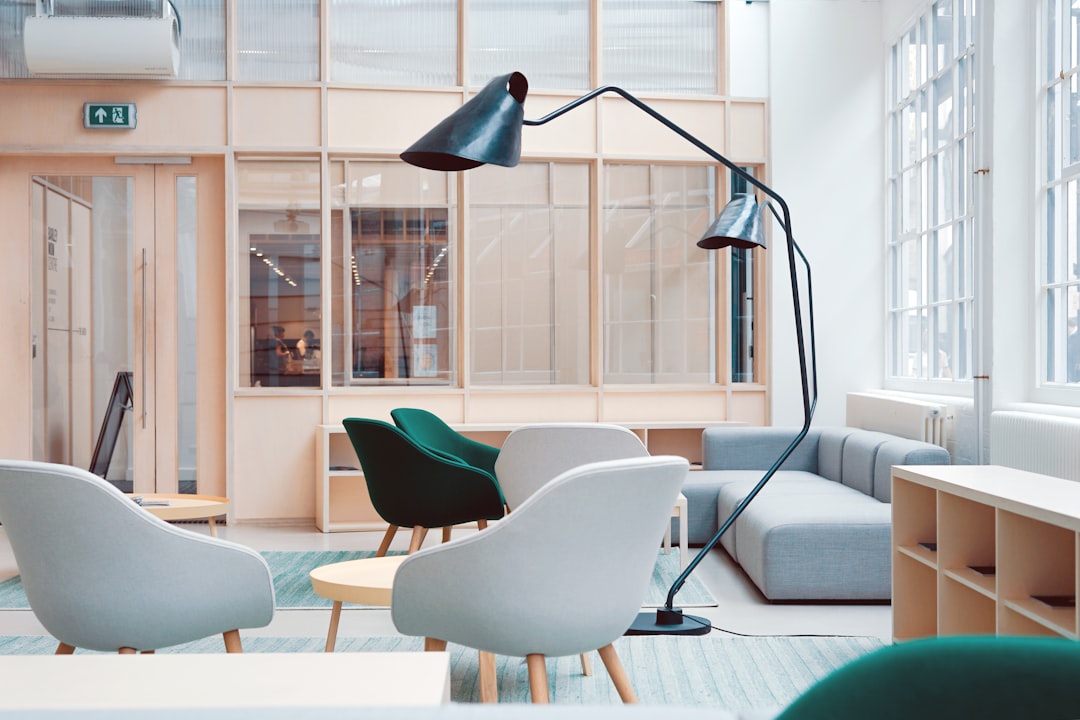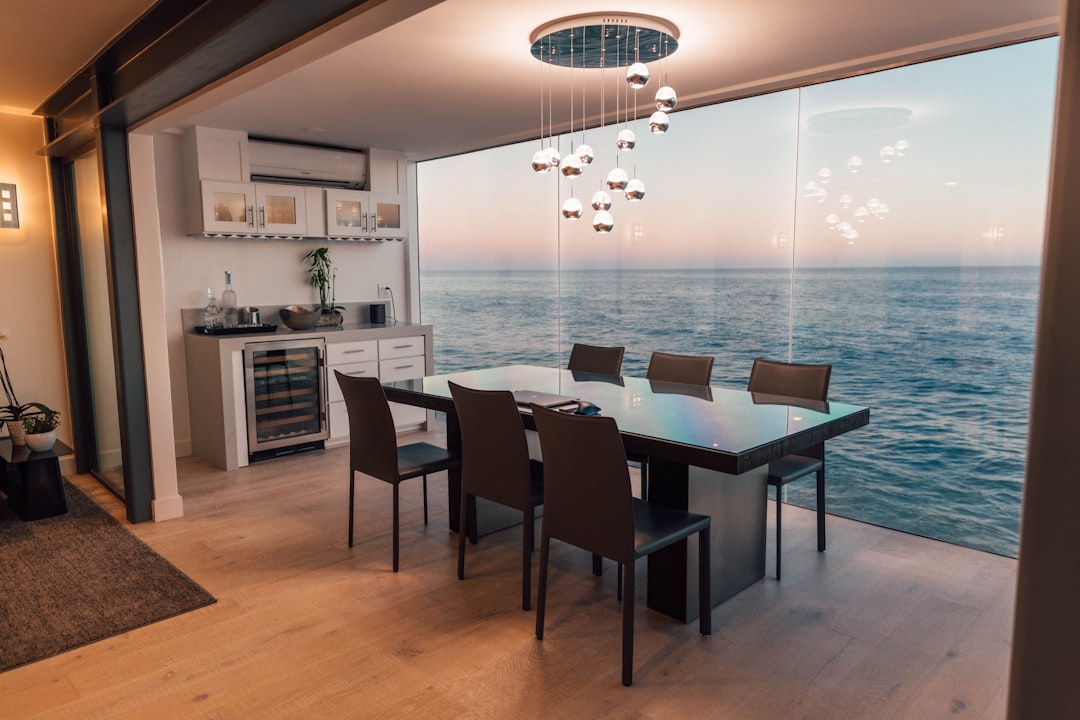Did you know industrial style homes are really popular now? They have exposed brick, metal, and reclaimed wood. This makes any room feel urban and chic.
We’re going to dive into industrial decor. We’ll cover what makes it special and how to add it to your home.
Key Takeaways
- Understand the core principles of industrial-inspired interior design
- Learn how to incorporate industrial decor into your living space
- Discover the benefits of using reclaimed and recycled materials
- Explore the role of lighting in industrial-style interiors
- Get tips on balancing industrial elements with other design styles
What is Industrial Style Interior Design?
Industrial style interior design comes from the industrial era. It adds history and character to today’s homes. It’s not just about looks; it’s about making spaces that work well and look great.
Key Characteristics of Industrial Design
Industrial style is known for exposed brick, metal accents, and reclaimed wood. These features bring authenticity and a raw, edgy look to any space.
Other important traits include open floor plans, high ceilings, and industrial materials like concrete and steel. These elements make spaces feel bigger and more open, even in small areas.
Understanding the Origins of Industrial Aesthetics
The roots of industrial aesthetics lie in the industrial era. Back then, factories and warehouses were turned into homes. This style celebrates the beauty of unfinished spaces, often with exposed ductwork and brick walls.
“The industrial style is all about embracing the raw and the unfinished, creating a space that feels both authentic and edgy.”
As urban design keeps changing, industrial style remains a favorite. It offers a unique mix of function and beauty. Knowing its key traits and origins helps homeowners create stunning, practical spaces.
Elements That Define Industrial Design
Industrial design focuses on simplicity. It uses raw materials, open spaces, and a focus on function. This style is popular for its modern and practical look.
Use of Raw Materials
Industrial design stands out for its use of raw materials like concrete, steel, and reclaimed wood. These materials enhance the look and add authenticity to the space.
Raw materials such as exposed brick and ductwork are often left visible. This adds to the industrial charm. It also shows the importance of honesty in design, where materials are not hidden.
Open Spaces and Floor Plans
Industrial design often features open floor plans. This creates a sense of spaciousness and freedom. It’s not just about looks; it also makes the space more functional.
By avoiding dividing walls, open spaces encourage interaction and flow. This makes the area feel larger. It’s great for smaller spaces, making them seem bigger.
Emphasis on Functionality
Functionality is key in industrial design. Spaces are designed to look good and work well. This is done with industrial furniture that’s both useful and stylish.
Furniture is made from materials like metal and wood. It’s designed to be practical and add to the space’s look. The result is a space that’s both beautiful and functional, following the principles of modern industrial design.
Choosing an Industrial Color Palette
A good color palette is key to an industrial look. It sets the mood and makes the space work well. Choosing the right colors is crucial for an industrial-inspired interior.
Industrial design mixes neutral tones with bold colors for a unique look. Neutral tones like grays, blacks, and whites are the base. They let bold accents stand out.
Common Color Schemes
Industrial design often uses monochromatic, complementary, and analogous schemes. A monochromatic scheme uses different shades of one color. This works well in minimalist industrial designs, focusing on simplicity.
In a loft, a monochromatic scheme ties everything together. For example, using gray shades from light to dark adds depth. It keeps the industrial feel while making the space feel bigger.
The Role of Neutrals
Neutrals balance the boldness of industrial elements. Neutral colors like beige, gray, and white soften the look of exposed brick and metal beams. They make the space more inviting and light.
“The use of neutral tones in industrial design is not just about aesthetics; it’s also about creating a functional space that feels welcoming and comfortable.”
Choosing a color palette that blends industrial and neutral tones is key. It makes a space stylish and functional. Whether it’s a minimalist industrial loft or an industrial-chic living room, the right colors matter a lot.
Furniture Trends in Industrial Design
Industrial design focuses on function and simplicity. It often uses metal and reclaimed wood. This style aims to create a space that feels raw and real.
Selecting the Right Materials
Choosing the right materials is key for an industrial look. Reclaimed wood and metal are essential. They give a rugged, unfinished feel that adds character to any room.
- Reclaimed wood for its warmth and history
- Metal for its durability and industrial feel
- Leather for its rugged, worn look
Mixing Vintage with Modern Pieces
Mixing vintage and modern furniture is a big trend in industrial design. This mix creates a unique and authentic look. For example, combining a vintage metal chair with a modern sofa adds depth and interest.
| Material | Vintage Style | Modern Twist |
|---|---|---|
| Reclaimed Wood | Old wooden crates | Sleek wooden coffee tables |
| Metal | Vintage metal lamps | Modern metal sculptures |
| Leather | Worn leather armchairs | Modern leather ottomans |
By mixing these elements, you can make a space that’s both industrial and welcoming. The trick is to balance the ruggedness of industrial pieces with the comfort of modern furniture.
Incorporating Lighting in Industrial Spaces
In industrial decor, lighting is more than just a need. It’s a design element that shapes the space’s feel and look. It makes the area feel more inviting and true to its industrial roots.
Popular Lighting Fixtures
Industrial spaces often use lighting that’s both tough and trendy. Metal pendant lights, exposed bulbs, and metal shade lamps are favorites. They light up the space well and add to its industrial charm.
Key Lighting Fixtures:
- Metal Pendant Lights: These are versatile and can be used in various settings, from kitchens to living rooms.
- Exposed Bulbs: Adding an edgy touch, exposed bulbs are often used in industrial settings to create a raw, unfinished look.
- Metal Shade Lamps: These lamps offer a blend of functionality and style, with metal shades that can be designed in various shapes and sizes.
Maximizing Natural Light
Getting more natural light is key in industrial lighting design. Big windows, skylights, and reflective surfaces help light up the space naturally. This cuts down on the need for artificial light and boosts the industrial look.
| Method | Description | Benefits |
|---|---|---|
| Large Windows | Installing large windows to let in more natural light. | Increases natural light, improves ventilation. |
| Skylights | Adding skylights to bring in natural light from above. | Enhances lighting, adds visual interest. |
| Reflective Surfaces | Using reflective surfaces like mirrors or metallic finishes. | Amplifies natural light, adds depth to the space. |
By picking the right lighting and using natural light, we can make industrial spaces look good and work well. They become places that are both beautiful and welcoming.
Textures that Enhance Industrial Interiors
In industrial style interior design, textures add depth and character. They make a room more appealing and engaging. The right textures can transform a space.
Industrial interiors often mix raw materials like wood and metal. Using Wood and Metal adds warmth and sophistication. For example, reclaimed wood can be used for furniture or flooring. Metal accents can be added through lighting or decorations.
Utilizing Wood and Metal
Wood and metal are key in industrial interiors. Wood brings warmth, while metal adds a sleek feel. Mixing them creates a modern yet inviting look.
A wooden coffee table with metal legs is a great example. It shows off the modern industrial style beautifully.
The Importance of Textural Contrast
Textural contrast is vital in industrial interiors. It adds interest and depth. Mixing textures like smooth metal and rough wood creates a dynamic space.
Adding materials like polished concrete or exposed brick enhances this contrast. For more ideas, check out industrial lounge interior design ideas.
In conclusion, textures are crucial in industrial interiors. By choosing and combining materials wisely, you can make a space both beautiful and functional.
Industrial Style in Different Spaces
Industrial design is not just for lofts anymore. It can be used in many parts of the home. This makes every room stylish and cohesive.
Living Room Inspirations
The living room is the heart of the home. Adding industrial touches makes it special and welcoming. Use exposed brick or concrete walls behind your furniture.
Industrial-style lighting, like metal pendant lights, adds authenticity. It makes the room feel real.
Kitchen and Dining Areas
Kitchens and dining areas can also get an industrial makeover. Reclaimed wood and metal accents give a rustic yet modern vibe. Industrial-style appliances and fixtures, like stainless steel sinks, enhance the look.
| Element | Description | Example |
|---|---|---|
| Reclaimed Wood | Wood salvaged from old buildings, used for furniture or accents. | Wooden dining table |
| Metal Accents | Metal used in lighting, fixtures, or decorative elements. | Metal pendant lights |
| Industrial Appliances | Appliances with an industrial look, such as stainless steel. | Stainless steel refrigerator |
Bedroom Designs
Bedrooms can also get an industrial makeover. Metal bed frames and exposed brick create a cozy and dramatic feel. Industrial-style lighting, like metal sconces, adds to the ambiance.
By adding industrial elements to different spaces, homeowners can create a unique and stylish home. It shows off their personal taste.
Accessories and Décor for Industrial Interiors
The industrial look is more than just raw materials and open spaces. It’s also about the right accessories and décor. These elements make a space feel more personal and welcoming.
Choosing accessories is all about finding the right balance. Industrial decor should look good and be useful. For example, metalwork or reclaimed wood can add charm while being practical.
Art and Wall Features
Art and wall features bring personality to an industrial space. We can use vintage signs, metal art, or big paintings to make a statement. The goal is to pick pieces that fit the industrial vibe, often with a raw, unfinished look.
Here are some tips for art and wall features:
- Pieces that use metal, wood, or other raw materials
- Abstract art that matches the industrial theme
- Vintage or repurposed items for a unique touch

Rugs and Fabrics
Rugs and fabrics can make an industrial space feel warmer and softer. We should pick materials and patterns that match the industrial look. Think neutral tones or textures that remind you of natural fibers.
Here are some tips for rugs and fabrics:
- Choose rugs with natural, earthy tones to ground the space
- Use fabrics with a rugged texture, like canvas or linen, for upholstery
- Stay away from fancy patterns and go for simpler designs
Tips for Achieving an Industrial Look
The secret to a great industrial design is finding the right mix of looks and use. To get this right, knowing the key parts of the minimalist industrial style is key.
Balancing Comfort and Aesthetics
Creating an industrial space can be tricky. It’s about mixing the tough look with comfort. Using industrial furniture that’s both useful and comfy is a good start. For example, furniture made from reclaimed wood or metal adds to the industrial vibe without making the space uncomfortable.
Adding soft touches like rugs, throw blankets, and pillows can also make the space cozier. These items bring warmth and make the industrial area feel welcoming.
Avoiding Over-Decorating
One mistake in industrial design is too much decoration. It can make the space look messy and lose its simple charm. Instead, choose a few standout items, like a striking light fixture or a unique industrial furniture piece, and keep the rest simple.
It’s also important to have some empty space. This lets the eye relax and enjoy the design. This way, we create a space that looks good and is also practical.
By following these tips, we can get a true minimalist industrial look. It’s both stylish and useful.
Common Mistakes to Avoid in Industrial Design
Industrial style interior design is more than looks; it’s about function too. It’s easy to focus too much on the style. But, forgetting about function can make a space look good but not work well.
Overlooking Functionality
One big mistake in industrial design is caring more about looks than use. Industrial spaces were made for work, not just to look good. Using materials that don’t last or furniture that’s not strong can mess up the space’s purpose.
- Choose materials and finishes that are durable and easy to maintain.
- Select furniture that’s functional and comfortable.
- Consider the flow of the space to ensure it meets your needs.
Misusing Color and Textures
Industrial design uses lots of textures and soft colors. But, using these wrong can make a space feel cold or unwelcoming. It’s key to find the right mix of textures and colors.
For example, mixing rough materials like concrete or brick with smoother ones like metal or wood looks great. Also, using mostly neutral colors with a few warm ones adds depth.
- Balance raw materials with smoother textures.
- Use a neutral color palette with strategic pops of color.
- Ensure the space remains functional and comfortable.
Avoiding mistakes like ignoring function and misusing colors and textures helps. This way, you can make an industrial-inspired space that looks good and works well.
How to Personalize Your Industrial Space
Making an industrial space your own is about mixing industrial chic with personal touches. Industrial design is simple and functional. But, adding your own style makes it feel welcoming and special.
Adding Personal Touches
To make an industrial space truly yours, add elements that show your taste. Hang artwork, family photos, or collectibles that mean something to you. For example, vintage maps or abstract art can bring personality to your space.
Textiles are another way to add a personal touch. Use throw blankets, pillows, or rugs in bold colors or patterns. They can soften the look of metal and concrete. This mix of textures adds warmth and visual interest.
Selecting Unique Statement Pieces
The secret to personalizing an industrial space is finding the right balance. Choose unique pieces that are both functional and have a story. They should reflect your style and the modern industrial theme.
For instance, a vintage door as a coffee table or a metal sculpture as a room divider can be striking. These pieces add character and enhance the industrial look while showing your taste.
Adding plants to your industrial space brings in greenery and freshness. Pick plants that do well indoors and fit the industrial look, like succulents or large planters.
Future Trends in Industrial Interior Design
Industrial interior design is changing with our lifestyles and environmental worries. We’re moving towards sustainable elements in loft design. This means using recycled materials, energy-saving lights, and green furniture that keeps the warehouse look but is good for the planet.
Eco-Friendly Innovations
The future of industrial design will bring more green solutions. Expect to see more natural materials, like reclaimed wood, and reused industrial parts. These will help make our spaces more eco-friendly.
Adapting to Changing Lifestyles
Our living and work spaces are evolving with us. Industrial design will need to be adaptable. It will include features for remote work, minimalism, and spaces that do many things. All while keeping the unique loft and warehouse feel.



